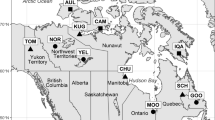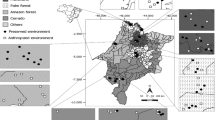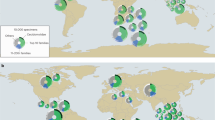Abstract
Nested subset structure has been studied in archipelagoes and fragmented habitats, and has been attributed to differential colonization and extinction rates among species and nested environmental tolerances. In this experiment, we tested for nestedness in assemblages of mycophagous fly larvae. Twenty mushrooms in each of three size classes (4.8–6.0 g, 10–15 g, 21–32 g) were placed on moist potting soil in experimental cups. The cups were placed in oak and pine forests in Greenville, S.C., USA for 5 days, where they were available to ovipositing flies. Upon collection, the mushrooms were incubated in the laboratory for 3 weeks and all emerging flies were sorted by species, counted, and weighed. A random placement analysis was conducted to determine whether the species richness pattern was a sampling artifact of the species abundance distributions. The actual species richness pattern did not conform to the random placement model; most mushrooms contained significantly fewer species than predicted by random sampling. The communities were strongly nested as measured by two different indices, and the nestedness pattern was related to mushroom size. Small mushrooms usually produced no flies or a single species, Dohrniphora sp. (Phoridae). Medium and large mushrooms typically produced more species-rich communities that usually contained the phorid and Drosophila putrida, D. tripunctata, and Leucophenga varia. This core guild was nested within a more diverse assemblage that included D. falleni, Mycodrosophila dimidiata, a muscid, and two Leptocera sp. (sphaeroceridae). These patterns are tentatively explained in the context of nested desiccation tolerances, mediated by differences in mushroom size.
Similar content being viewed by others
References
Beeby A (1993) Applying ecology. Chapman and Hall, London
Begon M, Harper JL, Townsend CR (1990) Ecology, 2nd edn. Blackwell, Boston
Blake JG (1991) Nested subsets and the distribution of birds on isolated woodlots. Conserv Biol 5: 58–66
Boecklin WJ, Gotelli NJ (1984) Island biogeographic theory and conservation practice: species-area relationships or speciousarea relationships? Biol Conserv 29: 63–80
Bolger DT, Alberts AC, Soule ME (1991) Occurrence patterns of bird species in habitat fragments: sampling, extinction, and nested species subsets. Am Nat 137: 155–166
Brown JH (1973) Species diversity of seed-eating desert rodents in sand dune habitats. Ecology 54: 775–787
Brown JH (1978) The theory of insular biogeography and the distribution of boreal birds and mammals. Great Basin Nat Mem 2: 209–227
Brown JH (1981) Two decades of homage to Santa Rosalia: toward a general theory of diversity. Am Zool 21: 877–888
Coleman BD, Mates MA, Willig MR, Hsieh Y (1982) Randomness, area, and species richness. Ecology 63: 1121–1133
Connell JH, Orias E (1964) The ecological regulation of species diversity. Am Nat 98: 399–414
Connor EF, McCoy ED (1979) The statistics and biology of the species-area relationship. Am Nat 113: 791–833
Courtney SP, Kibota TT, Singleton TA (1990) Ecology of mushroom-feeding Drosophilidae. Adv Ecol Res 20: 225–274
Cutler A (1991) Nested faunas and extinction in fragmented habitats. Conserv Biol 5: 496–505
Doak DF, Mills LS (1994) A useful role for theory in conservation. Ecology 75: 615–626
Hanski I (1982) Dynamics of regional distributions: the core and satellite species hypothesis. Oikos 38: 210–221
Kadmon R (1995) Nested species subsets and geographic isolation: a case study. Ecology 76: 458–465
Kodric-Brown A, Brown JH (1993) Highly structured fish communities in Australian desert springs. Ecology 74: 1847–1855
Krebs CJ (1994) Ecology, 4th edn. HarperCollins College Publishing, New York
Lewis GP, Worthen WB (1992) Effects of predation and microenvironment on the survival of Drosophila tripunctata larvae. Oikos 64: 553–559
MacDonald KA, Brown JH (1992) Using montane mammals to model extinctions due to global change. Conserv Biol 6: 409–415
Patterson BD (1987) The principle of nested subsets and its implications for biological conservation. Conserv Biol 1: 323–334
Patterson BD (1990) On the temporal development of nested subset patterns of species composition. Oikos 59: 330–342
Patterson BD, Atmar W (1986) Nested subsets and the structure of insular mammalian faunas and archipelagos. Biol J Linn Soc 28: 65–82
Patterson BD, Brown JH (1991) Regionally nested patterns of species composition in granivorous rodent assemblages. J Biogeogr 18: 395–402
Pianka ER (1992) Evolutionary ecology, 4th edn. Harper and Row, New York
Ricklefs RE (1990) Evology, 3rd edn. Freeman, New York
Ricklefs RE, Schluter D (1993) Species diversity in ecological communities. University of Chicago Press, Chicago
Simberloff D, Levin B (1985) Predictable sequences of species loss with decreasing island area—land birds in two archipelagos. N Z J Ecol 8: 11–20
Simberloff D, Martin JL (1991) Nestedness of insular avifaunas: simple summary statistics masking complex species patterns. Ornis Fenn 68: 178–192
Sokal RR, Rohlf FJ (1981) Biometry, 2nd edn. Freeman, San Francisco
Soulé ME, Simberloff D (1986) What do genetics and ecology tell us about the design of nature reserves? Biol Conserv 35: 19–40
Soulé ME, Alberts AC, Bolger DT (1992) The effects of habitat fragmentation on chaparral plants and vertebrates. Oikos 63: 39–47
Tellería JL, Santos T (1995) Effects of forest fragmentation on a guild of wintering passerines: the role of habitat selection. Biol Conserv 71: 61–67
Worthen WB (1988) Slugs (Arion spp.) facilitate mycophagous drosophilids in laboratory and field experiments. Oikos 53: 161–166
Worthen WB (1989a) Predator-mediated coexistence in laboratory communities of mycophagous Drosophila (Diptera: Drosophilidae). Ecol Entomol 14: 117–126
Worthen WB (1989b) Effects of resource density on mycophagous fly dispersal and community structure. Oikos 54: 145–153
Worthen WB, McGuire TR (1988) A criticism of the aggregation model of coexistence: non-independent distribution of dipteran species on ephemeral resources. Am Nat 131: 453–458
Worthen WB, Hipp MN, Twardokus CT, Roller R (1993) Effects of ant predation and larval density on mycophagous fly communities. Oikos 66: 526–532
Worthen WB, Mayrose S, Wilson RG (1994) Complex interactions between predation, rainfall, and microclimate: effects on mycophagous fly communities. Oikos 69: 277–286
Worthen WB, Bloodworth BR, Hobbs MB (1995) Habitat variability in the effects of predation and microclimate on mycophagous fly communities. Ecography 18: 248–258
Wright DH (1983) Species-energy theory: an extension of speciesarea theory. Oikos 41: 496–506
Wright DH, Reeves JH (1992) On the meaning and measurement of nestedness of species assemblages. Oecologia 92: 416–428
Wylie JL, Currie DJ (1993) Species-energy theory and patterns of species richness. I. patterns of bird, angiosperm, and mammal species richness on islands. Biol Conserv 63: 137–144
Zar JH (1996) Biostatistical analysis, 3rd edn. Prentice-Hall, Englewood Cliffs
Author information
Authors and Affiliations
Corresponding author
Rights and permissions
About this article
Cite this article
Worthen, W.B., Carswell, M.L. & Kelly, K.A. Nested subset structure of larval mycophagous fly assemblages: nestedness in a non-island system. Oecologia 107, 257–264 (1996). https://doi.org/10.1007/BF00327910
Received:
Accepted:
Issue Date:
DOI: https://doi.org/10.1007/BF00327910




